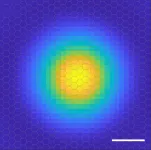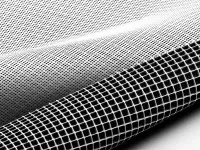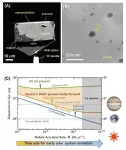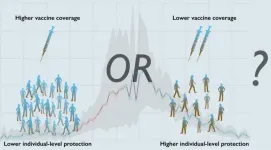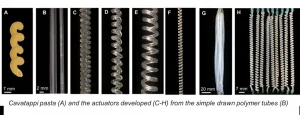(Press-News.org) In a world-first, researchers from the Okinawa Institute of Science and Technology Graduate University (OIST) have captured an image showing the internal orbits, or spatial distribution, of particles in an exciton - a goal that had eluded scientists for almost a century.
Excitons are excited states of matter found within semiconductors - a class of materials that are key to many modern technological devices, such as solar cells, LEDs, lasers and smartphones.
"Excitons are really unique and interesting particles; they are electrically neutral which means they behave very differently within materials from other particles like electrons. Their presence can really change the way a material responds to light," said Dr. Michael Man, co-first author and staff scientist in the OIST Femtosecond Spectroscopy Unit. "This work draws us closer to fully understanding the nature of excitons."
Excitons are formed when semiconductors absorb photons of light, which causes negatively charged electrons to jump from a lower energy level to a higher energy level. This leaves behind positively charged empty spaces, called holes, in the lower energy level. The oppositely charged electrons and holes attract and they start to orbit each other, which creates the excitons.
Excitons are crucially important within semiconductors, but so far, scientists have only been able to detect and measure them in limited ways. One issue lies with their fragility - it takes relatively little energy to break the exciton apart into free electrons and holes. Furthermore, they are fleeting in nature - in some materials, excitons are extinguished in about a few thousandths of a billionth of a second after they form, when the excited electrons "fall" back into the holes.
"Scientists first discovered excitons around 90 years ago," said Professor Keshav Dani, senior author and head of the Femtosecond Spectroscopy Unit at OIST. "But up until very recently, one could generally access only the optical signatures of excitons - for example, the light emitted by an exciton when extinguished. Other aspects of their nature, such as their momentum, and how the electron and the hole orbit each other, could only be described theoretically."
However, in December 2020, scientists in the OIST Femtosecond Spectroscopy Unit published a paper in Science describing a revolutionary technique for measuring the momentum of the electrons within the excitons.
Now, reporting on 21st April in Science Advances, the team used the technique to capture the first ever image that shows the distribution of an electron around the hole inside an exciton.
The researchers first generated excitons by sending a laser pulse of light at a two-dimensional semiconductor - a recently discovered class of materials that are only a few atoms in thickness and harbor more robust excitons.
After the excitons were formed, the team used a laser beam with ultra-high energy photons to break apart the excitons and kick the electrons right out of the material, into the vacuum space within an electron microscope.
The electron microscope measured the angle and energy of the electrons as they flew out of the material. From this information, the scientists were able to determine the initial momentum of the electron when it was bound to a hole within the exciton.
"The technique has some similarities to the collider experiments of high-energy physics, where particles are smashed together with intense amounts of energy, breaking them open. By measuring the trajectories of the smaller internal particles produced in the collision, scientists can start to piece together the internal structure of the original intact particles," said Professor Dani. "Here, we are doing something similar - we are using extreme ultraviolet light photons to break apart excitons and measuring the trajectories of the electrons to picture what's inside."
"This was no mean feat," continued Professor Dani. "The measurements had to be done with extreme care - at low temperature and low intensity to avoid heating up the excitons. It took a few days to acquire a single image."
Ultimately, the team succeeded in measuring the exciton's wavefunction, which gives the probability of where the electron is likely to be located around the hole.
"This work is an important advancement in the field," said Dr. Julien Madeo, co-first author and staff scientist in the OIST Femtosecond Spectroscopy Unit. "Being able to visualize the internal orbits of particles as they form larger composite particles could allow us to understand, measure and ultimately control the composite particles in unprecedented ways. This could allow us to create new quantum states of matter and technology based on these concepts."
INFORMATION:
The Dead Sea Scrolls, discovered some seventy years ago, are famous for containing the oldest manuscripts of the Hebrew Bible (Old Testament) and many hitherto unknown ancient Jewish texts. But the individual people behind the scrolls have eluded scientists, because the scribes are anonymous. Now, by combining the sciences and the humanities, University of Groningen researchers have cracked the code, which enables them to discover the scribes behind the scrolls. They presented their results in the journal PLOS ONE on 21 April.
The scribes who created the scrolls did not sign their work. Scholars suggested ...
Floodwaters are not what most people consider a blessing. But they could help remedy California's increasingly parched groundwater systems, according to a new Stanford-led study. The research, published in Science Advances, develops a framework to calculate future floodwater volumes under a changing climate and identifies areas where investments in California's aging water infrastructure could amplify groundwater recharge. As the state grapples with more intense storms and droughts, stowing away floodwaters would not only reduce flood risks but also build more water reserves for ...
Addressing a much-debated question about the impact of stress on survival in wild, nonhuman primates, a new multi-decadal study involving 242 wild female baboons found evidence to support chronic stress as a significant factor affecting survival. The study found that a female baboon with a stress response - as reflected in fecal glucocorticoid concentrations, a biomarker of stress response - in the top 90% for her age throughout adulthood was expected to lose 5.4 years of life compared to a female with glucocorticoid concentrations in the bottom 10% for her age group. The findings, which leveraged more than 14,000 fecal glucocorticoid measurements over a ...
MADISON, Wis. -- Tens of millions of people worldwide are affected by diseases like macular degeneration or have had accidents that permanently damage the light-sensitive photoreceptors within their retinas that enable vision.
The human body is not capable of regenerating those photoreceptors, but new advances by medical researchers and engineers at the University of Wisconsin-Madison may provide hope for those suffering from vision loss. They described their work today in the journal Science Advances.
Researchers at UW-Madison have made new photoreceptors from human pluripotent stem cells. However, it remains challenging to precisely deliver those photoreceptors within the diseased or damaged eye so that ...
Water is abundant in our solar system. Even outside of our own planet, scientists have detected ice on the moon, in Saturn's rings and in comets, liquid water on Mars and under the surface of Saturn's moon Enceladus, and traces of water vapor in the scorching atmosphere of Venus. Studies have shown that water played an important role in the early evolution and formation of the solar system. To learn more about this role, planetary scientists have searched for evidence of liquid water in extraterrestrial materials such as meteorites, most of which originate from asteroids that formed in the early history of the solar system.
Scientists have even found water as hydroxyls and molecules in meteorites in the context ...
Two of the COVID-19 vaccines currently approved in the United States require two doses, administered three to four weeks apart, however, there are few data indicating how best to minimize new infections and hospitalizations with limited vaccine supply and distribution capacity. A study published on 21st April, 2021 in the open access journal PLOS Biology by Seyed Moghadas at York University in Toronto, Canada, and colleagues suggests that delaying the second dose could improve the effectiveness of vaccine programs.
The emergence of novel, more contagious SARS-CoV-2 variants has led to a public health debate on whether to vaccinate more individuals with the first ...
Swing voters in battleground states delivered Donald Trump his unexpected victory in the 2016 presidential election, suggests a new study coauthored by Yale political scientist Gregory A. Huber.
The study, published on April 21 in the journal Science Advances, compares the outcomes of the 2012 and 2016 presidential elections in six key states: Florida, Georgia, Michigan, Nevada, Ohio, and Pennsylvania. The analysis merged voter turnout records of 37 million individuals with precinct-level election returns to determine the sources of Trump's electoral success. It examined the relative roles of conversion -- voters switching their support from one party to the ...
Boston, MA - In a worldwide survey, pregnant and postpartum women reported high levels of depression, anxiety, loneliness, and post-traumatic stress during the COVID-19 pandemic, according to researchers at Harvard T.H. Chan School of Public Health. Such high levels of distress may have potential implications for women and for fetal and child health and development, according to the study.
The study will be published online in PLOS ONE on April 21, 2021.
"We expected to see an increase in the proportion of pregnant and postpartum women reporting mental health distress, as they are likely to be worried or have questions about their babies' health and development, ...
In the field of robotics, researchers are continually looking for the fastest, strongest, most efficient and lowest-cost ways to actuate, or enable, robots to make the movements needed to carry out their intended functions.
The quest for new and better actuation technologies and 'soft' robotics is often based on principles of biomimetics, in which machine components are designed to mimic the movement of human muscles--and ideally, to outperform them. Despite the performance of actuators like electric motors and hydraulic pistons, their rigid form limits how they can be deployed. As robots transition to more ...
Researchers of the University of Barcelona, together with researchers from the University of Zurich (Switzerland) and Brown University (United States), have analysed more than 10,000 evaluations that were carried out to candidates who wish to hold a public teaching permanent in Catalonia. The objective was to study how the decision by the committee of evaluators is affected by the fact that each candidate holds a certain position in the lists of people to be assessed. The study, published in the journal Science Advances, identifies a new cognitive bias that researchers have named "generosity-erosion effect". It involves that once the evaluators have scored one candidate generously, ...
